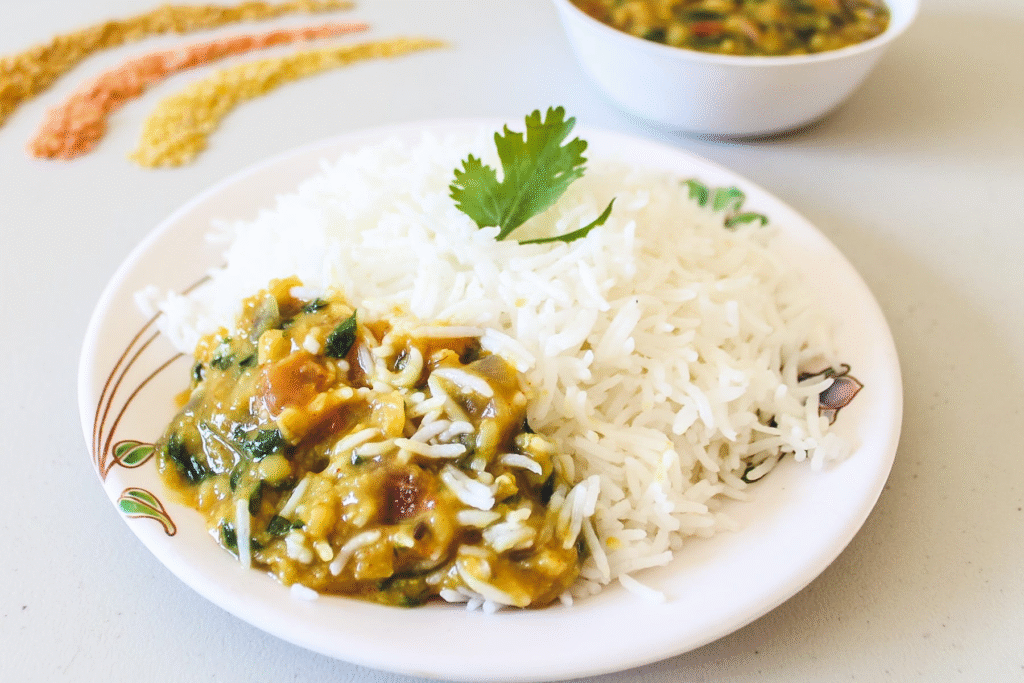Methi Dal is a wholesome and flavorful North Indian lentil dish that beautifully combines the earthy goodness of lentils with the subtle bitterness of fresh fenugreek leaves (methi). This hearty dal is made using a comforting blend of three protein-rich lentils—toor dal (pigeon peas), moong dal (split yellow lentils), and masoor dal (red lentils)—each bringing its own texture and nutrition to the dish. The lentils are pressure-cooked until soft and creamy, then simmered in a classic Punjabi-style onion-tomato masala infused with warming spices and aromatic garlic, ginger, and green chilies.
What makes this dal truly stand out is the addition of fresh methi leaves, which lend a distinctive taste with a slightly bitter edge that balances beautifully with the mellow, rich lentils and tangy tomatoes. This combination not only enhances the flavor but also boosts the dish’s nutritional profile, as methi is packed with iron, fiber, and antioxidants.
Perfect for an everyday meal, methi dal pairs wonderfully with steamed basmati rice or warm phulkas/rotis. You can round out the meal with crunchy papad, tangy pickle, and a fresh cucumber-onion salad for added texture and zing. Whether you’re looking for a comforting bowl of dal after a long day or a satisfying vegetarian main for lunch or dinner, this dish fits the bill—wholesome, balanced, and packed with flavor.
It’s simple enough for weeknight cooking but special enough to serve to guests who appreciate Indian home-style meals that are both nourishing and deeply satisfying.
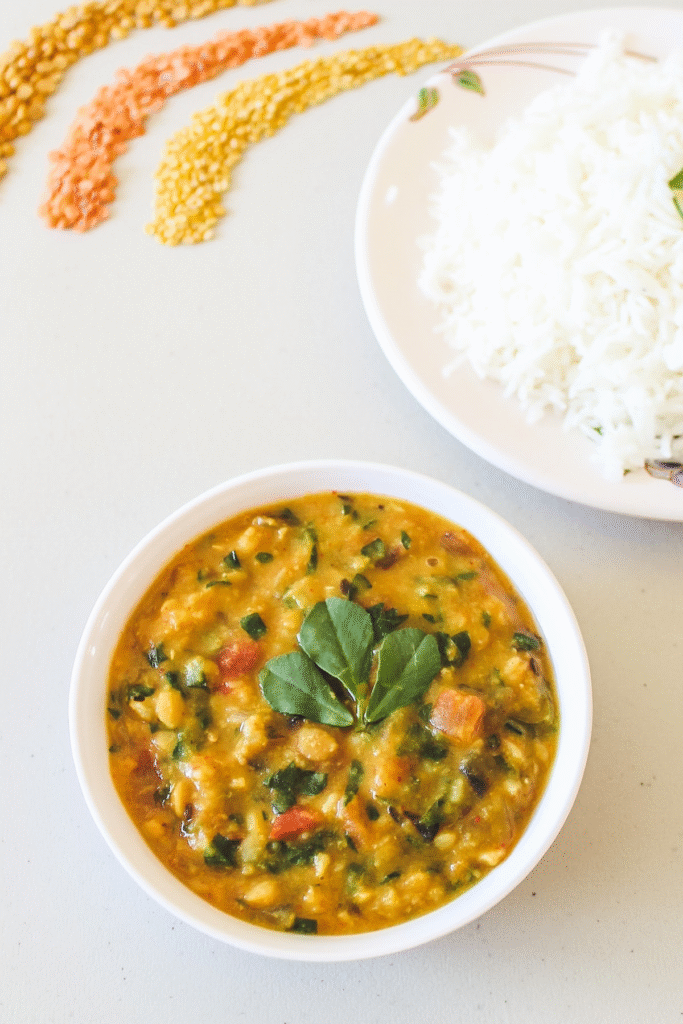
❤️ You’ll Love This Methi Dal Recipe
Taste & Flavor:
- Fresh fenugreek leaves (methi) infuse the dish with their distinct earthy bitterness, which perfectly offsets the soft, creamy texture of the lentils, creating a harmonious and comforting depth of flavor. Rather than overwhelming the dish, this subtle bitterness adds a sophisticated depth that enhances the overall flavor profile and makes every bite more comforting and satisfying.
- This dish offers a gentle, medium warmth that enhances without overwhelming, allowing the wholesome, natural flavors of the ingredients to take center stage. You can easily adjust the spice level to suit your taste—whether you prefer a gentle warmth or a bolder, spicier kick.
- What makes this dal truly special is that it relies on minimal spice powders—just a touch of turmeric and red chili powder. This restrained use of spices allows the distinct taste of the lentils to come forward in its purest form. Their rich, nutty flavor is not masked but elevated, resulting in a wholesome and nourishing meal that feels both simple and gourmet.
Methi dal is a wholesome and satisfying choice for both kids’ and adults’ lunch boxes. Pack it in an insulated container to keep it warm, and pair it with steamed rice or jeera rice stored separately to maintain freshness and prevent sogginess. This hearty combination makes for a balanced, nourishing meal that’s easy to carry and comforting to eat.
It’s also ideal for meal prep! You can cook a big batch over the weekend and refrigerate it in airtight containers for up to 3–4 days. For extended storage, freeze individual portions in freezer-safe containers—perfect for those hectic or lazy days when you need a quick, homemade meal without the extra effort. Just thaw, reheat, and enjoy a warm, delicious serving of methi dal whenever you need it.
🧾 Ingredient Notes
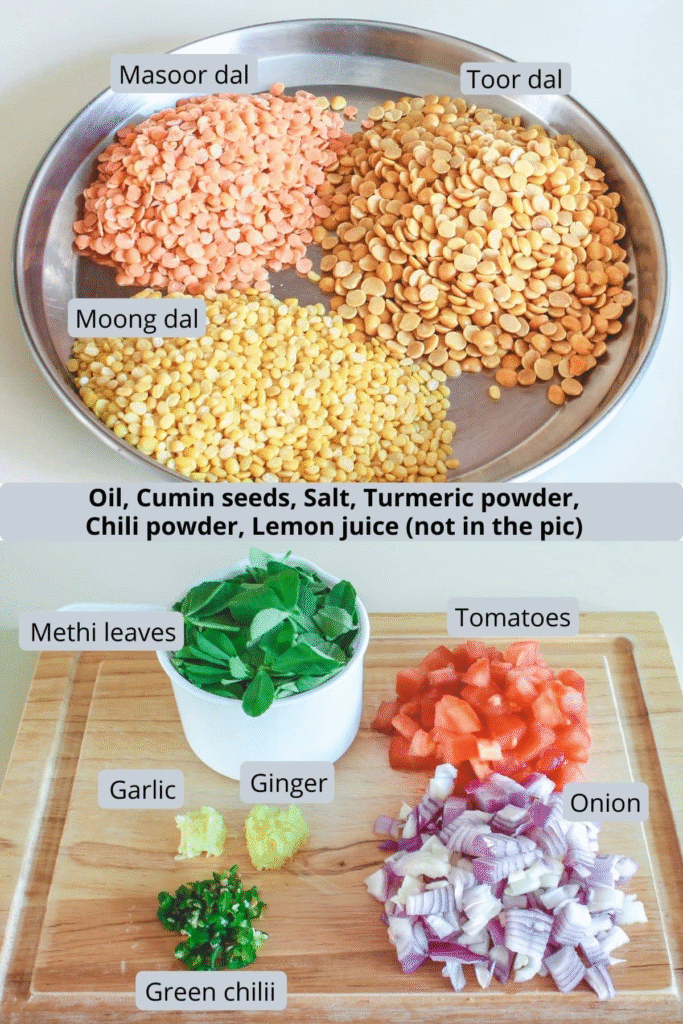
- Lentils: I’ve used a trio of lentils—moong dal, masoor dal, and toor dal—for a wholesome and flavorful base. Feel free to mix and match any two, or even stick to just one type depending on your preference. Experimenting with different combinations helps keep everyday dal meals exciting and diverse.
- Methi (Fenugreek) Leaves: Fresh methi leaves are always my first choice—they add a wonderful earthy aroma. But on days when fresh methi isn’t available at the store, I opt for frozen methi, which is a great substitute without compromising too much on taste.
- Frozen Methi Tip: I usually go with the Vadilal brand for frozen methi, as it contains fewer stems and is easier to cook with. Brands like Deep or Surti tend to have more fibrous stems, which can be tough and unpleasant to eat, so I avoid those.
- Skip the Garam Masala: Believe it or not, this methi dal shines without the addition of garam masala. It’s packed with flavor on its own—don’t be afraid to leave it out!
- Ginger & Garlic: I used freshly grated ginger and garlic in this batch, which added a burst of freshness. These days, I often grind ginger, garlic, and green chilies together in the wet jar of my spice grinder—quick and effective!
- Lemon or Lime Juice: A splash of lemon or lime juice at the end is essential—it brightens up the dish and ties all the flavors together beautifully. Just remember to add it once you’ve turned off the heat. Boiling the dal after adding citrus can dull its vibrant tang.
👩🍳 How to make methi dal? (stepwise photos)
1) Combine the three types of lentils (toor dal, moong dal, and masoor dal) in a bowl.Wash thoroughly under a stream of cold water two to three times, or until the rinsing water runs completely clear and free of cloudiness. Transfer the washed dals to a pressure cooker with fresh water.
2) Secure the lid and place the pressure cooker on medium heat. Cook for 3 to 4 whistles. After cooking, let the pressure release on its own completely before carefully opening the lid.

3) While the dal is cooking, begin preparing the masala on a separate burner. Heat oil in a pan over medium flame. When the oil is hot, add cumin seeds and let them crackle for a few seconds.
4) Add the ginger-garlic paste along with the finely chopped green chili and give it a good stir to blend the flavors. Sauté for around a minute, just until the raw smell disappears and the mixture becomes fragrant.
5) Add finely chopped onions along with a pinch of salt to help them cook faster.
6) Cook until the onion turns light brown in color.
7) Add chopped tomatoes and fresh fenugreek (methi) leaves to the pan.
8) Mix everything well and cook until the tomatoes break down and become pulpy, and the methi leaves are wilted and tender.
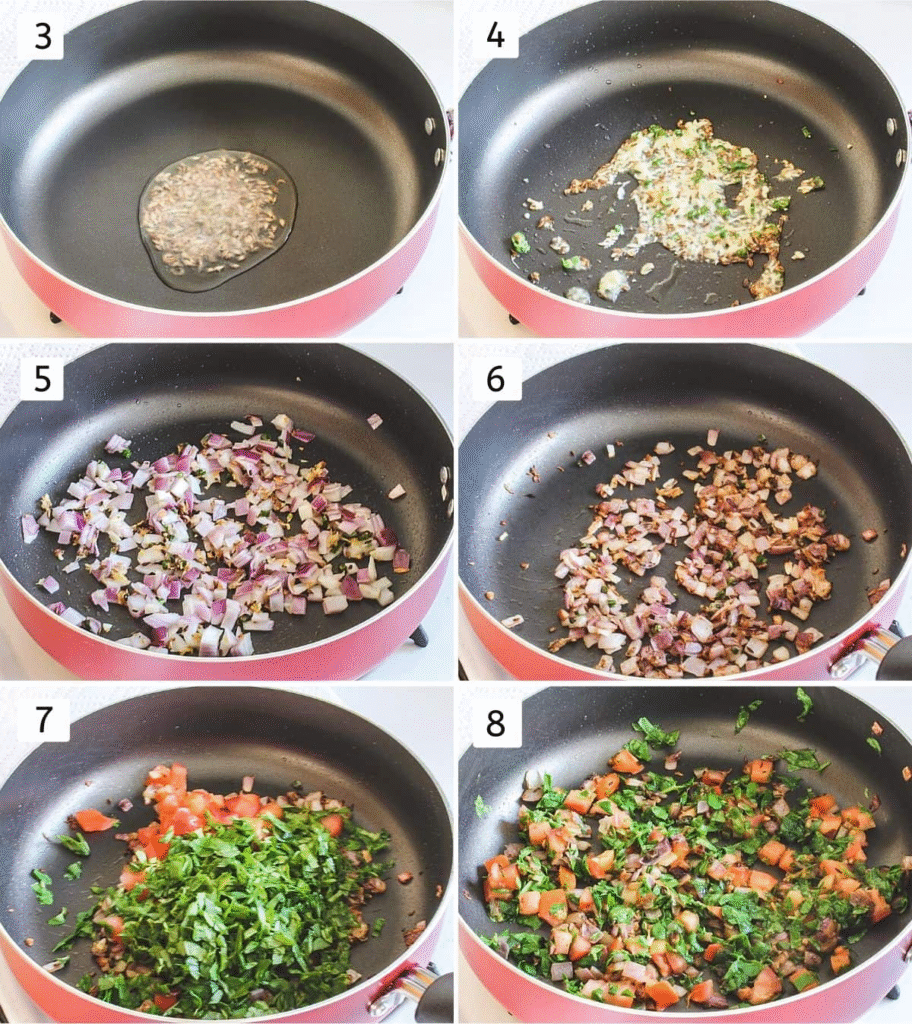
9) Pour the cooked dal into the masala. Add the remaining salt, turmeric powder, and red chili powder.
10) Stir everything together until well combined.
11) Adjust the consistency by adding water as needed. Let the dal simmer gently for 5 to 7 minutes so the flavors meld beautifully.
12) Turn off the heat and finish with a squeeze of fresh lemon juice. Give it a final stir. Your flavorful methi dal is now ready to serve hot with rice or roti.
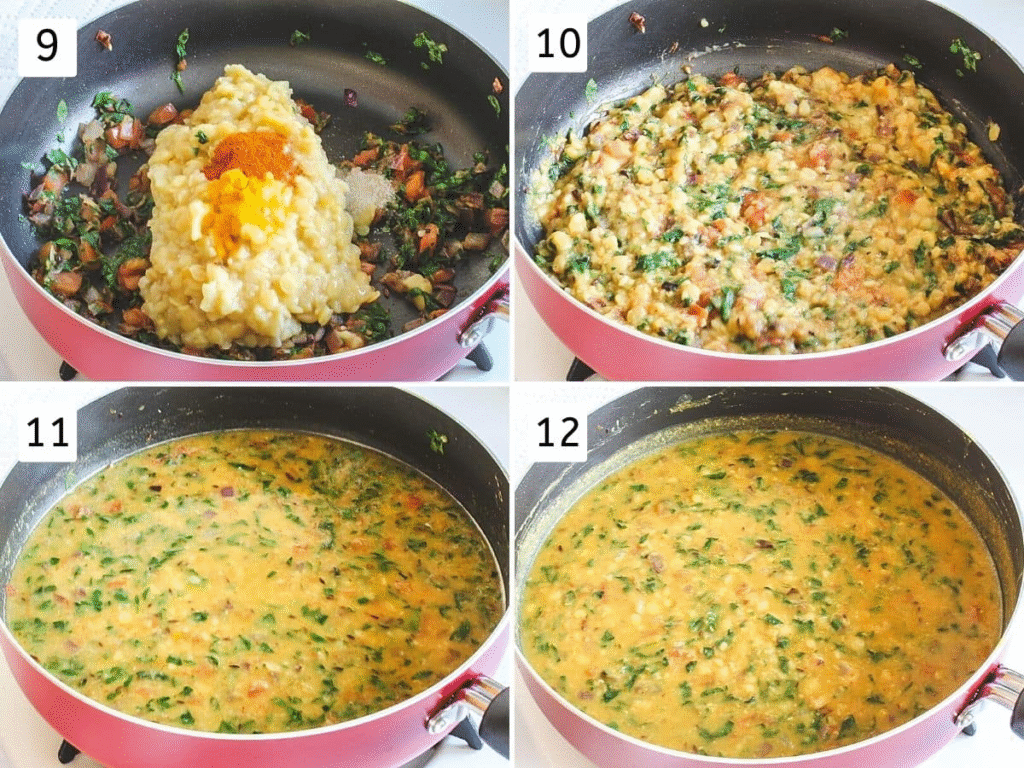
💭 Expert Tips
Adjust the spice level by increasing or decreasing the green chili and red chili powder amount.
How to get rid of the bitterness of methi leaves?
- Begin by thoroughly washing the fresh methi (fenugreek) leaves under cold running water to remove any dirt, grit, or impurities. Once cleaned, transfer the leaves to a colander or a wide sieve and let the excess water drain off completely.
- Sprinkle a generous pinch of salt evenly over the washed methi leaves. Gently toss or mix the leaves with your fingers to ensure that the salt is well distributed throughout. This step is crucial as the salt will help to extract the natural bitterness from the methi.
- Allow the salted methi leaves to sit undisturbed for about 10 to 15 minutes. During this resting period, the salt works to draw out the internal moisture from the leaves, which also carries much of the inherent bitterness.
- Once the time is up, take a handful of methi leaves at a time and gently squeeze them between your palms or fingers to extract the bitter liquid. You’ll notice a greenish, slightly foamy liquid being released — this is where most of the bitterness lies. Discard this water.Continue squeezing the remaining leaves in the same manner until all of them have been thoroughly pressed and the excess moisture has been discarded. The leaves are now ready to be used in your dish and will have a noticeably milder, more balanced flavor.

🍽 Serving Ideas
- Methi dal pairs wonderfully with a simple bowl of hot, steamed basmati rice, making it a wholesome and comforting meal. For added flavor, serve it alongside fragrant jeera rice, which complements the earthy tones of fenugreek beautifully.
- If you’re in the mood for an Indian bread pairing, enjoy methi dal with soft, freshly made rotis or crisp, golden parathas. Both options soak up the dal deliciously and make for a satisfying bite.
- To elevate the meal into a traditional Indian thali-style experience, add a refreshing cucumber-onion-tomato salad on the side, a crunchy roasted or fried papad, and a spoonful of spicy mango or lemon pickle. To round it off, a chilled glass of chaas (spiced buttermilk) not only aids digestion but also balances the warm spices in the dal, making your meal complete, nutritious, and truly satisfying.
